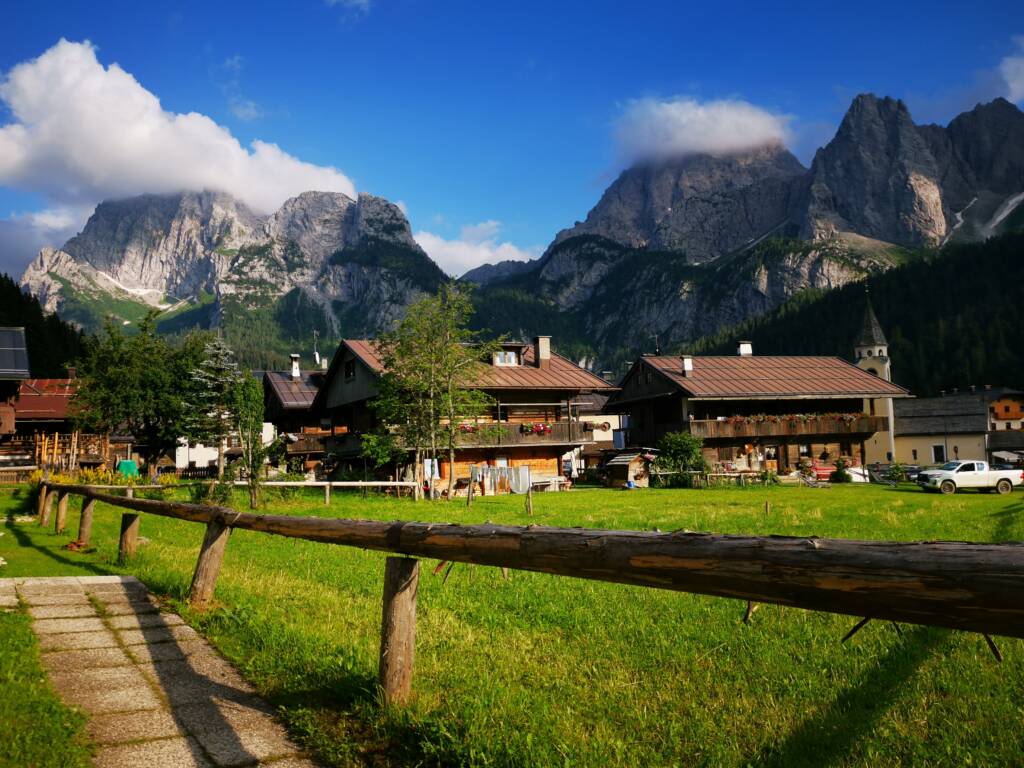Going up the Sappada valley, after a hairpin bend we reach the most isolated hamlet of Sappada, called Zepodn, a small nucleus gathered next to the church of Sant’Osvaldo, dating to 1732. It has a portico open on the sides modelled on the Alpine churches found in Carnia and is surrounded by the small cemetery. After its restoration in 2000 it displays some stained glass windows by Arrigo Poz, including one of the pilgrimage to Maria Luggau.
On the other side of the square, the modern structure of the conference hall also houses the G. Fontana Ethnographic Museum: founded in the 1970s. Moved and expanded in 2009 to its new location, it offers a complete itinerary from the natural environment to the identity of the Sappada community.
The visitor is introduced to displays covering the geology, flora and fauna of the Sappada basin, which hosted its first human inhabitants in the Middle Ages. The ethnographic collections show how the environment shaped their habits: the relative isolation of the past, the particular climatic conditions, together with the peculiar identity of the community as a German-speaking linguistic island, favouring a socio-economic system of day-to-day life that was almost self-sufficient. This is evidenced by the architectural typologies, the period images, clothing, and objects in daily use as well as the tools used in agricultural-forestry-pastoral and artisanal activities.
The village of Cima, dominated by Monte Siera and surrounded by fields, also dotted with numerous small votive chapels, has a large number of wooden houses with a great chromatic and dimensional variety, each with some detail to admire.
These include small square windows, closed by bars, a chimney flue protruding from the facade, a date, a carving, or a house’s coat of arms. In the centre of the hamlet, among the many wooden structures, stands an ancient 17th century stone building, the Kratter s’Gaigars house, which attracts attention as it stands out from the character of the other buildings for various elements such as the tympanum, the arch that frames the entrance with a vaulted atrium and the mullioned (or bifora) window above.
Among the various examples of traditional wooden architecture, the 18th century s’Gea(d)ratn – Schpanglars house is particularly interesting, inside which the stone fireplace with its ancient smokehouse is preserved. Next to one of the three fountains in the village there stands a small building, used as a washhouse (bòschkuchl).
Passing through the entire village along the interior road, you can admire several buildings, some of which are two or three stories high. In the direction of Plòtzn you can passes along the asphalted provincial road that enters the woods, towards the Springs of the Piave. After a few hundred metres, a deviation to the left descends towards the Piave River, on whose banks you can admire an old sawmill (Kòttrar soge), built on a beautiful and abundant waterfall, and a couple of old mills (the s’Jacklars mihle and Sindar mihle), now both transformed into private homes.
The name of Sappada is linked to the Piave River, Plodn in Sappadan dialect, toponyms of controversial origin as to their etymology: “Sappada” may derive from Zepodn, a Sappadan term for Cima Sappada, located high up, on the massif, or from zapata / sapada (meaning ‘hoe’), which would indicate the way in which the inhabitants would have worked the land. “Plodn”, on the other hand, would appear to originate from Longaplave, with which the Patriarchs of Aquileia designated the location (Longa Plavis) and which refers to the river that flows through it, the Piave.

